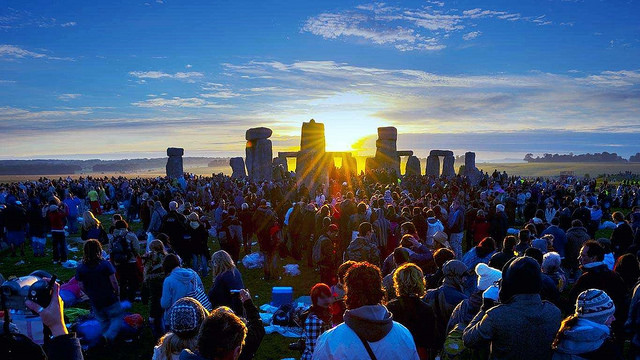The June summer solstice is an astronomical event that marks the first official day of summer in the Northern Hemisphere and it is also the day that the sun reaches its most Northern point in the sky.
The summer solstice is the day of the year we receive the most sunlight and depending on location, many places will experience 16 hours of daytime.
The summer solstice will occur on June 21st at 16:38 UTC (universal time) and happens at exactly the same time across the world. Click here to convert the time to your own timezone.
The word solstice generates from the Latin word solstitium from sol (sun) and stitium (to stand still), as it appears as though the sun stops at the solstice. As the days get longer the sun rises until it seems as though it stops high up in the sky at the same point; the sun seems as though it remains in this position all day during the solstice period.
The solstice is also known as Midsummer (from Shakespeare), Litha (Wiccan), St. John’s Day, All Couples Day, Feast of Epona and many more.
For those that live in the Northern Hemisphere the June solstice is the longest day of the year, whereby, the Southern Hemisphere will be marking the beginning of winter.
Each year we have two solstices, a winter one and a summer one. In the Northern Hemisphere the winter one happens in December and the summer one happens in June and the opposite way around for the Southern Hemisphere.
The earth often has its warmest days in the month or two following the summer solstice as the tilt of the Earth’s axis allows the rays of the sun to hit one hemisphere more directly.
The Northern hemisphere is furthest from the sun so it receives approximately seven percent less sunlight than the Southern hemisphere receives during its summer.
In June all locations north of the equator receive sunlight for more than 12 hours, whereby locations south of the equator receive less than 12 hours.
Approximately 5,000 years ago people arranged huge stones in a circle in Stonehenge, England to align with the June summer solstice sunrise.
At around the same time Egyptians built two great pyramids and a Sphinx so that if you stood at the Sphinx and gazed towards the pyramids you can see the sun set directly between them.
The Solstice is associated with weddings; June is typically a favourite month chosen for marriages to take place.
It is also a time of harvest for planting crops and also known traditionally as a great time for pregnancies as it would result in a baby born during the spring.
The summer solstice is also a celebration of the birthday of the sun and just like the queen, the sun celebrates two birthdays a year.
The solstice is traditionally celebrated with festivals and rituals often representing religious themes and fertility.
Pagans celebrate the solstice with themes showing the balance between fire and water with rituals taking place during their festival known as Litha.
In ancient China the summer solstice is a celebration of Yin, with the winter solstice celebrating the Yang, as the yin and yang wax and wane in reverse proportion with each other.
The sun is approximately 94 million miles away from Earth during the summer solstice.
Worldwide many people mark the solstice with festivals, celebrations, traditions and rituals which often include rising early to watch the sunrise and staying up late to watch it set.
Relephant:
Summer Solstice & the Dark Moon: Nothing is Impossible.
Relephant bonus—Four Reminders to help us Appreciate Every Day of this Life:
~
Author: Alex Myles
Images: Paul Townsend/Flickr; Let’s Go Out/Flickr
Editor: Travis May




Read 1 comment and reply